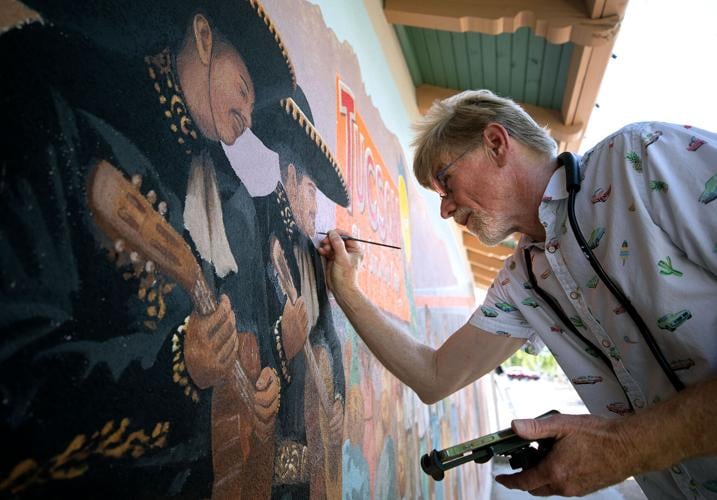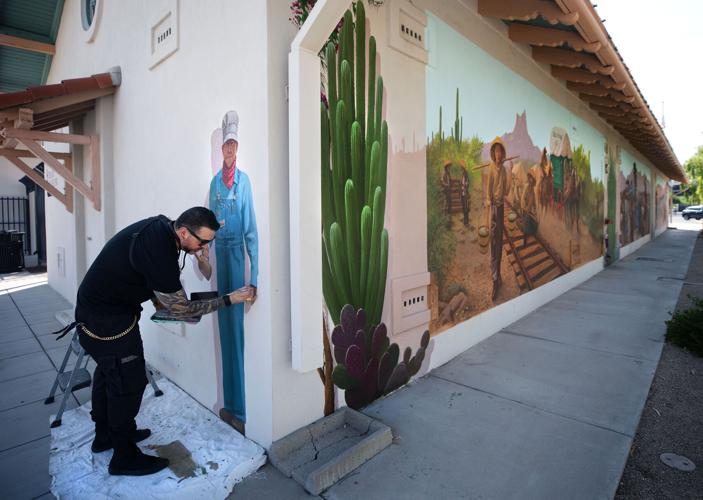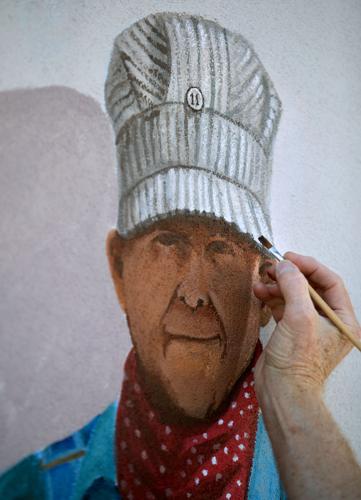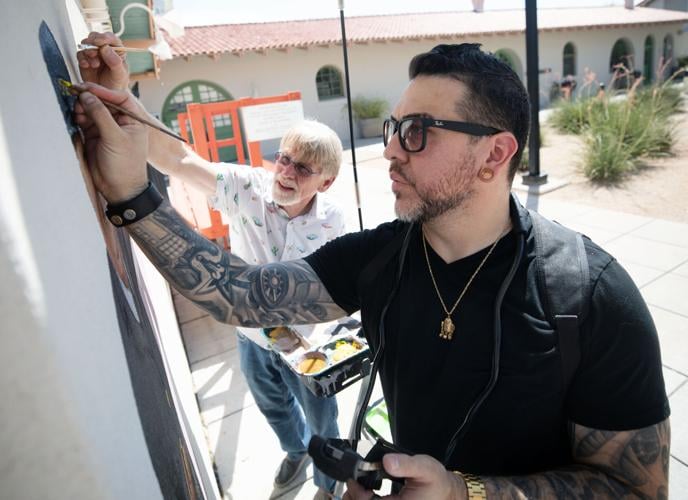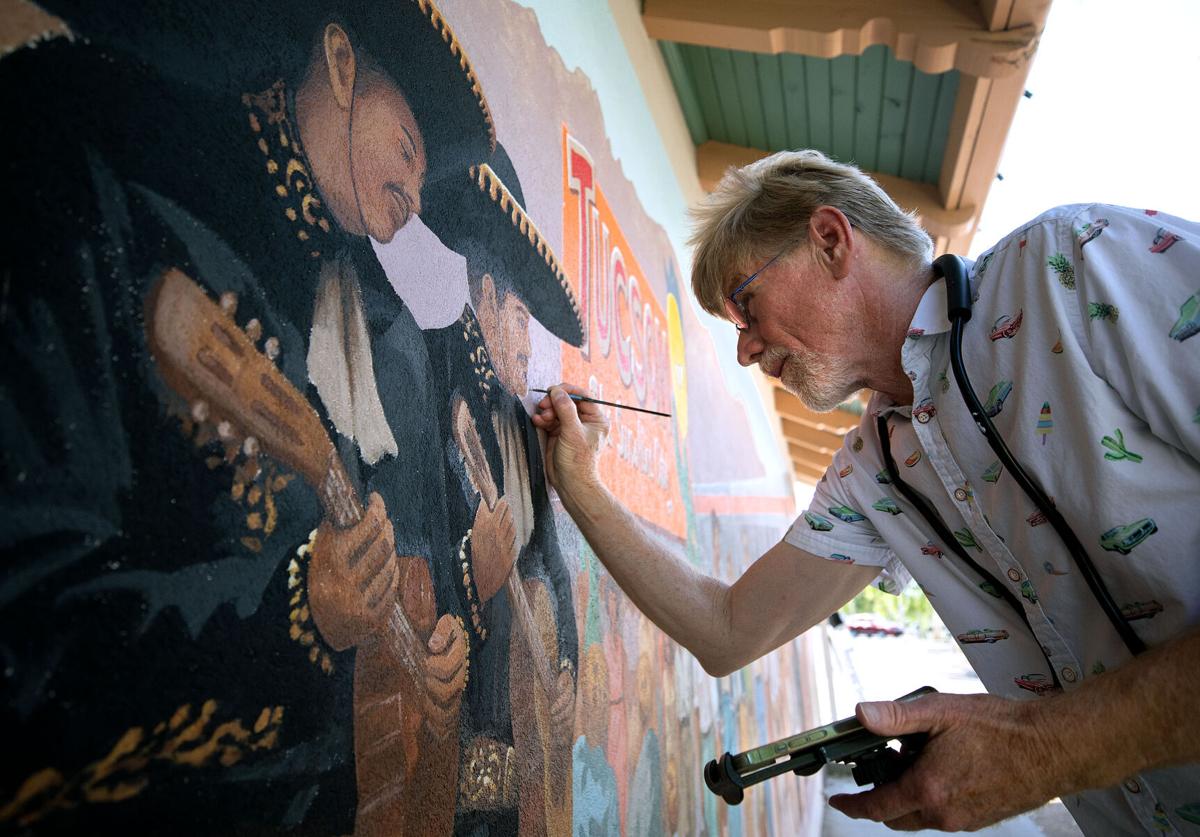Artist Bill Singleton has spent the last year chugging away, learning about the history of the railroad in Tucson, for his latest work at the Southern Arizona Transportation Museum.
The mural, entitled “Arrival of the Railroad: The Mural That Tells the Multicultural Story," offers perspectives of three time periods crucial to the construction and use of the railroad in Southern Arizona.
“The train coming here is probably one of the most pivotal incidents in Tucson history,” said fine artist Singleton. “Because before that, I think there were like 7,000 people. And then once the train arrived, people started coming in and they could get goods cheaper, they could export stuff like copper and cotton and import clothing, and so then Tucson started really growing.”

Gabriel Singleton, right, and his father, Bill Singleton, work on a portion of the mural outside of the Southern Arizona Transportation Museum.
Singleton has been working with the museum, 414 N. Toole Ave., on the piece for about a year. He and museum officials have collaborated directly with members of the Tucson Chinese Cultural Center, the African American Museum of Southern Arizona and the Tohono O’odham Nation to ensure the piece illustrates historical accuracy.
“We consulted, besides myself, four or five other historians,” said museum historian Bill Kalt. “We met extensively with the Chinese group because they were so crucial to the building of the railroad.”
The mural is separated into three panels that add up to 1,000 square feet.
The first section highlights the initial construction of the railroad near Picacho Peak. A Chinese water boy, the centerpiece of the panel, carries buckets balanced on a bamboo pole. The water boy wasn’t originally part of the piece until members of the Chinese Cultural Center recommended he should be included to maintain historical accuracy.
“Sandy Chan (an educator from the Chinese Cultural Center) spent hours with us,” said museum director Kenneth Karrels. “She told us if the bamboo poles should be different colored hues or if something wasn’t correct.”

Gabriel Singleton, son of Bill Singleton, works on a portion of the mural outside of the Southern Arizona Transportation Museum. The mural is a year in the making.
The panel also depicts two Tohono O’odham women foraging in the desert as a Tully and Ochoa Company freight wagon passes railroad workers, soon to be outpaced by the steam-engine train.
The second section showcases former Tucson mayor Estevan Ochoa presenting the Silver Spike in celebration of the railroad’s completion in Tucson in 1880. Ochoa, despite the fact that his freight business would go under, sponsored legislation to allow the train to come to the Sonoran Desert.
“You see greedy businessmen nowadays, but this guy had a vision for the community that he didn’t want to fail,” Kalt said.
Ochoa is surrounded by local leaders in top hats, cowboys and a diverse crowd of Tucsonans. The diamond stack locomotive seen behind the crowd is an accurate depiction of what the train likely looked like, though Kalt says there are surprisingly no photos found from that day. The Silver Spike Jubilee is held every March in honor of the the railroad that dramatically changed the course of Tucson’s history.

Artist Bill Singleton created three panels to tell the history of the railroad on a mural outside of the Southern Arizona Transportation Museum.
The third panel jumps to the 1950s, where University of Arizona students, families and new visitors hop off the Amtrak, which still serves the Tucson community today.
“A couple more of the people who we consulted were from the U of A to make sure we had the letter jacket right,” Kalt said. “I just really tried to do my homework.”
Singleton says he made this panel the most diverse of all, representing how much of a melting pot Tucson has become.
Throughout the year spent working on the piece, Singleton, Kalt and Karrels also met with the descendants of those who worked on the railroad. Singleton used the representatives from Tucson’s multicultural communities, the descendants he met with and volunteers for the museum as muses for the people he painted in the mural.
“Bill even put me in,” Kalt said. “He said that he put in over 98 different Tucsonans.”

Bill Singleton puts the finishing touches on Jerry, a retired train engineer and volunteer, who is depicted in the mural.
The mural can be seen on the western wall of the museum on Toole Avenue. The museum has not yet set a date for a public dedication.
For those wanting to explore more of the museum, head inside to learn the full history of how locomotives brought better infrastructure and cultural shifts to Tucson. Visitors can also enter the gate and head toward the train tracks to ring the bell of the train used in the 1955 musical “Oklahoma!”
“The idea here is to educate,” Karrels said. “We want to entertain folks because you retain more when you have fun.”
The Southern Arizona Transportation Museum, 414 N. Toole Ave., is open 11 a.m. to 3 p.m. Sundays and Tuesdays through Thursdays; and 10 a.m. to 4 p.m. Fridays and Saturdays. Admission is free and exhibits are in both English and Spanish.
Those interested in volunteering with the museum can email satm1673@outlook.com or call 520-623-2223 for more information. Visit the website to learn about the museum’s history and upcoming events.


